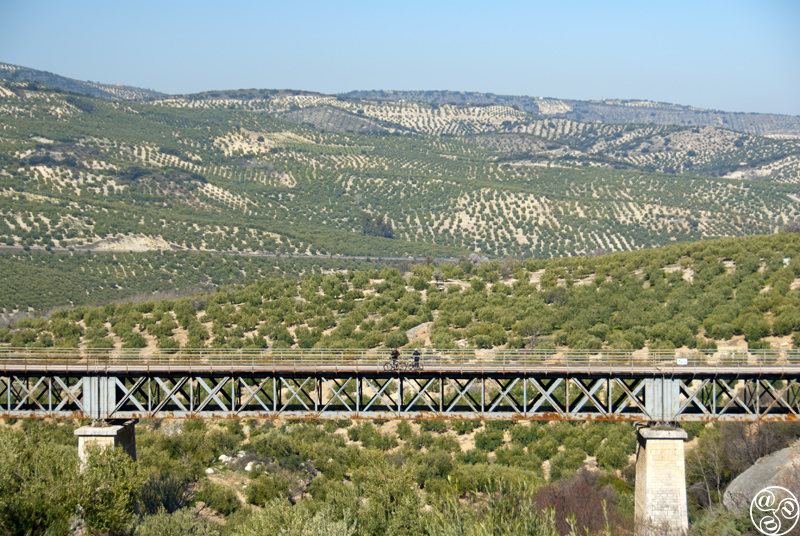
Via Verde - Sierras Subbéticas
The Via Verde Subbeticas is a southern extention of the Vía Verde of the Olive Oil that originates in Jaen city. The Via Verde Subbeticas covers 56 km, much of it on the fringes of the limestone mountainous area of the Sierras Subbéticas Natural Park. It links a series of beautiful villages, such as Zuheros, Luque and Cabra, crossing several magnificent viaducts and passing through a tunnel. This vía verde (railway path) is suitable for hikers, cyclists and wheelchair users. It climbs gently from 400m to a peak of around 600m just past Zuheros in the first 20km, before descending to 300m over the remaining distance.
The Route
The railway path starts at a spectacular point: the viaduct over the Guadajoz river, a natural border between Jaen and Cordoba provinces. On this first stretch, as the track snakes through the hills via some deep cuttings, there are fine views back over the steep-sided Guadajoz valley and the surrounding olive groves.
At Km 3 is a ruined railway halt where another narrower train line used to meet this one. The minor track ran south to a mine in Zamoranos and minerals extracted from here were then transported to the mainline, to this halt at Km 3, and loaded onto a larger train. Mules would then tow the mining train uphill to Zamoranos.

Continuing along the route you can see the expanse of the Laguna del Conde, otherwise known as Laguna Salobral due to the lake's saline waters. Spring is the best time to see the lake, since its banks are covered in flowers and its waters are densely populated with breeding and migrating species of duck, flamingos and waders, among other birds. There are several miradores along here that are excellent vantage points for seeing the lake.
The railway path crosses the N432 via a footbridge and at Km 10 is the first station of this route, the Estación de Luque. It's a convenient stopping place since there is a restaurant in the old station itself and you can even take a shower in the building where the steam engines used to fill with water. You can visit Luque on a dirt track that climbs up from the station to this hilltop village, capped by a castle.
Worth the 7km detour north (especially if you're cycling) is the attractive town of Baena, famed for its high-quality olive oil. Baena and Luque were once linked by a railway line but little of this remains. You can also walk to Baena along drovers tracks, but you'll need a good topographical map.

From Luque it's around 6km to the next village of Zuheros, close to the rugged edges of the Sierras Subbéticas park. There is a stopping area and a fountain where the road to Baena leaves Zuheros, a good place for appreciate the climb up to the village of Zuheros - if you want to visit it - teetering on top of a dramatic rocky outcrop. The next stopping area has a renovated station house where there are several of the helpful information boards that line this route. If you do opt for the ascent to Zuheros, you'll be rewarded with an unbeatable view down to the railway path.
For those who don't mind another substantial climb, you can visit the Cueva de los Murciélagos, with some outstanding limestone rock formations and cave paintings, up a steep but spectacular road leading into the mountainous park.
Back on the track, at Km 17 is a superb100m-long iron bridge, the Puente de Zuheros, which curves majestically over the Arroyo Bailón. Looming above the bridge is Zuheros crowned by its Moorish castle.
A good place for a stop is at Km 20, a shady spot with the tiny station of Doña Mencía, now converted into a restaurant. At Km 22 there is mirador where you can stop and admire the panoramic views of Doña Mencía village.
The route runs alongside the old road that links Zuheros and Cabra, now superceded by the newer A316. Before the descent to Cabra at Km 26, there is the route's only tunnel, which is 140m long. Immediately afterwards is one of the railway path's most impressive bridges: the 132m-long iron Viaducto de la Sima spanning the Arroyo del Fresno river.
A couple of bridges later you can see Cabra, a pretty mountain village with a castle and several interesting churches. At Km 33 in the village's former station, which dates from the 19th century and has been lovingly restored, is an information centre for the vía verde, the Centro de Interpretatión del Tren del Aceite (957 522 777). There is a fascinating museum on the history of the Subbética route, with exhibitions and a Mikado train, as well as a bar, El Andén, furnished to reflect its former function as a railway waiting room.
After Cabra, the vía verde threads its way through olive groves. After another bridge, the 90m-long Viaducto del Barranco del Alamedal at Km 39, there are increasingly more vineyards than olive groves. This is because the towns of Moriles and Montilla are nearby, both of which have their own denomination for the celebrated sherries they produce.
Don't miss Lucena, a large town with an unexpected rich choice of handsome buildings and churches. After Lucena at Km 44 is the town's former station, now somewhat abandoned, and then Lucena's industrial estate.
After leaving the town behind the route continues through olive groves and vineyards again before reaching the final stop at Km 53: the well-preserved grand building of the Moriles-Horcajo station that, despite its name, used to serve the village of Las Navas del Selpillar. From here it's easy to visit Moriles and sample some of the village's sherry in one of its bodegas.